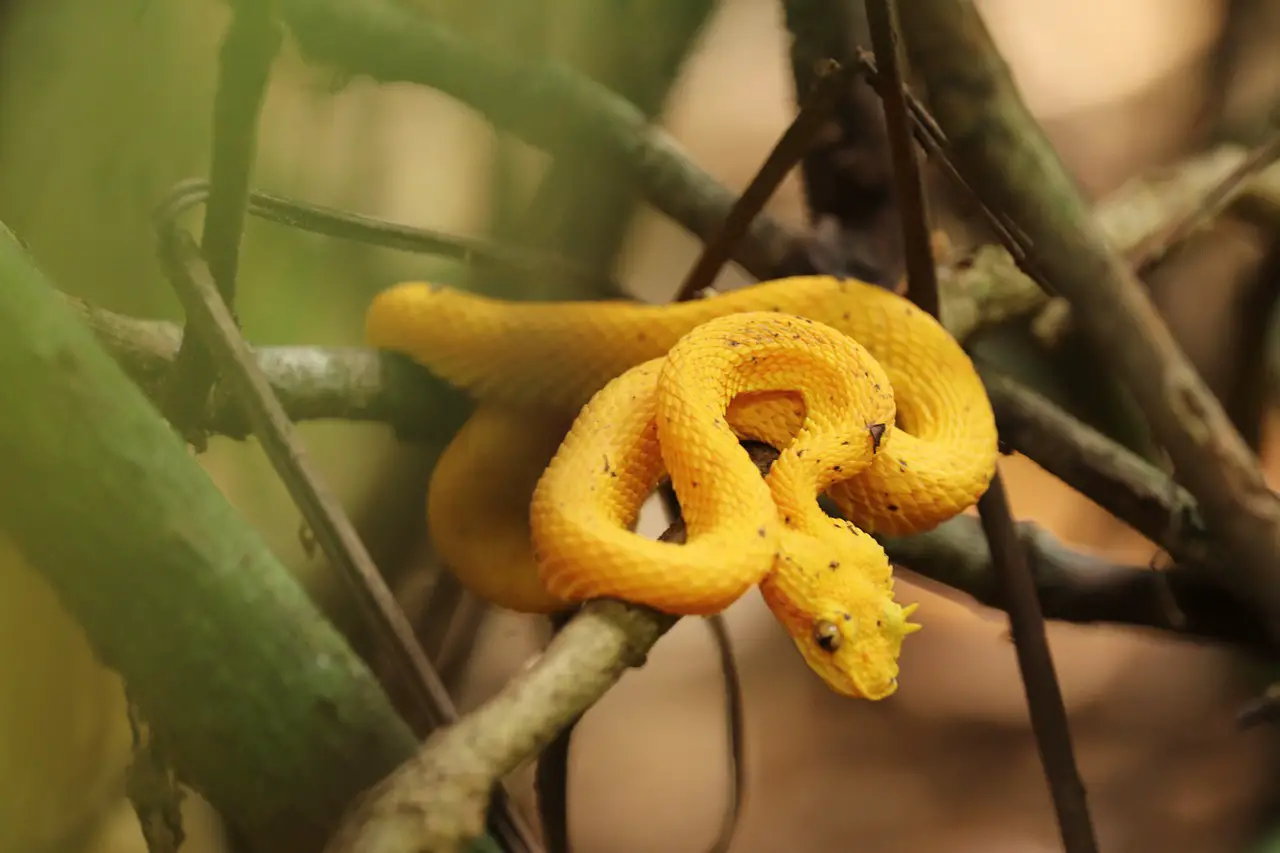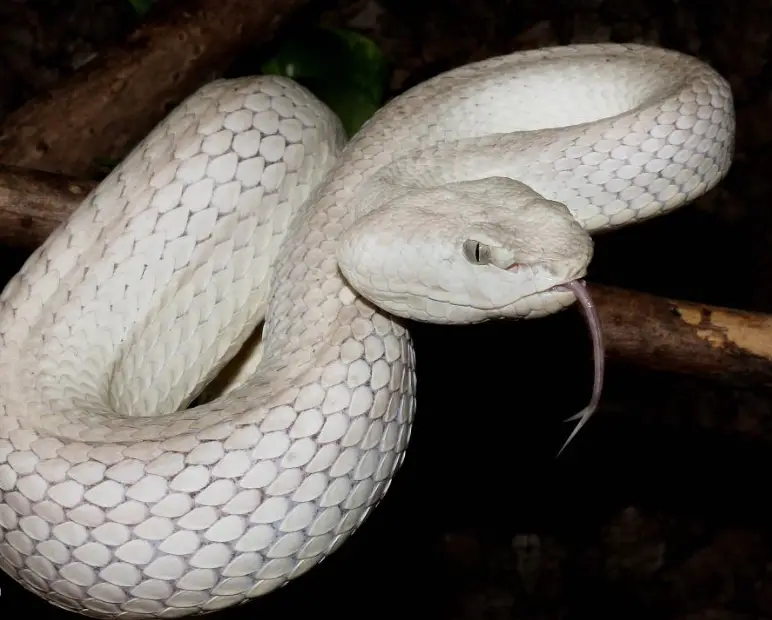White pit vipers, also known as white-lipped pit vipers, are a fascinating species of venomous snakes that inhabit various regions around the world. Their striking appearance, unique adaptations, and potent venom make them captivating subjects of study for both herpetologists and nature enthusiasts. In this article, we will delve into the intriguing world of white pit vipers, exploring their characteristics, habitats, behavior, and the significance of their venom.
You may also want to know the difference between a coral or king snake.
Overview of White Pit Vipers
Appearance
White pit vipers derive their name from the distinct white coloration on their lips or scales. However, it’s important to note that the term “white” is used loosely, as these snakes may exhibit a range of colors, including pale yellow, cream, or light gray. Their bodies are covered in overlapping scales, giving them a rough texture, and they typically have a stout build. These vipers can grow to varying lengths depending on the species, with some reaching up to four feet.
Habitat
White pit vipers can be found in diverse habitats across different continents, including Asia, Africa, and Central America. They are well-adapted to thrive in various environments, such as tropical rainforests, dense vegetation, and rocky terrain. These snakes often favor areas near water sources, as they play a vital role in their hunting and hydration.
Behavior
White pit vipers are primarily nocturnal, preferring to hunt and explore during the cover of darkness. Their excellent camouflage allows them to blend seamlessly into their surroundings, making them efficient ambush predators. These vipers possess a heat-sensing pit organ located between their eyes and nostrils, which aids in detecting warm-blooded prey in the darkness.
Venomous Arsenal: Adaptations and Significance
Venom Composition
The venom of white pit vipers is a complex cocktail of enzymes, proteins, and toxins. It serves two main purposes: immobilizing their prey and aiding in digestion. The venom contains potent hemotoxins, which attack the circulatory system, and cytotoxins, which cause tissue damage. It is essential to note that white pit vipers, like all venomous snakes, play a crucial role in maintaining the balance of ecosystems by controlling populations of small mammals and other prey species.
Defensive Behavior
When threatened, white pit vipers exhibit defensive behavior to protect themselves. They may coil up and strike if provoked or cornered. These vipers are known for their intimidating defensive displays, which include hissing, flattening their bodies to appear larger, and exposing their fangs as a warning to potential threats.
Medical Significance
While the venom of white pit vipers can be dangerous and potentially fatal to humans, it also holds significant medical potential. Certain components of the venom have been studied for their potential therapeutic uses, such as treating blood disorders and developing pain-relieving medications. Research continues to shed light on the remarkable properties of snake venom and its potential applications in medicine.

Diversity of White Pit Vipers
White-Lipped Pit Viper (Trimeresurus albolabris)
The white-lipped pit viper, native to Southeast Asia, is one of the most well-known and studied species within the white pit viper group. It exhibits a range of colors, including shades of green, yellow, and white. These vipers are arboreal, often found perched on trees, and possess potent venom.
Central American Bushmaster (Lachesis stenophrys)
The Central American bushmaster is a large and highly venomous white pit viper species found in Central America. It is known for its distinctive white coloration, along with dark brown or black markings. This viper inhabits various forested areas and is considered one of the most dangerous venomous snakes in the region.
White-Tailed Pit Viper (Bothriechis albonatus)
The white-tailed pit viper, endemic to Costa Rica and Panama, is another remarkable member of the white pit viper group. It showcases a vibrant green body with white markings and a distinct white tail. These vipers are primarily arboreal and play an essential role in maintaining the ecological balance of their habitat.
Conservation and Human Interaction
Threats
White pit vipers face numerous threats that impact their populations. Habitat destruction, primarily due to deforestation and urbanization, poses a significant risk to their survival. The illegal wildlife trade also puts pressure on these snakes, as they are often captured and sold as exotic pets or for their skins. Climate change and habitat fragmentation further compound the challenges faced by these enigmatic serpents.
Conservation Efforts
Conservation initiatives play a vital role in protecting white pit vipers and their habitats. Efforts to preserve natural areas, enforce regulations against illegal wildlife trade, and educate local communities about the importance of these snakes are crucial for their survival. Research on their behavior, ecology, and venom also aids in developing effective conservation strategies.
Fascination and Fear: Cultural Perceptions
White pit vipers have been subjects of both fascination and fear in various cultures. In some regions, they are revered as symbols of power, wisdom, and transformation. However, due to their venomous nature, they are also associated with danger and caution. Cultural understanding and respect for these snakes are essential for promoting coexistence and conservation efforts.
Conclusion
White pit vipers, with their striking appearance and venomous capabilities, remain captivating creatures of the wild. Their adaptations, diverse species, and significance in ecosystems contribute to the intricate tapestry of nature. While they inspire both awe and caution, it is vital to appreciate and protect these enigmatic serpents, ensuring their survival for generations to come.
FAQs
1. Are white pit vipers aggressive towards humans?
White pit vipers are generally shy and prefer to avoid human contact. However, if threatened or cornered, they may exhibit defensive behavior and strike. It’s important to exercise caution and respect their natural habitats when encountering these snakes.
2. Can white pit vipers be kept as pets?
Keeping white pit vipers as pets is not recommended due to their venomous nature. They require specialized care, permits, and expertise to ensure their well-being and the safety of the keeper. It’s best to appreciate these snakes in their natural habitats or through educational programs at reputable zoos.
3. Are all white pit vipers venomous?
Yes, all white pit vipers are venomous. Their venom varies in potency and composition, but caution should always be exercised when encountering any species of pit vipers.
4. How can one avoid snake bites from white pit vipers?
To avoid snake bites from white pit vipers, it is essential to be aware of their presence in their respective habitats. Stay on designated paths while hiking, wear appropriate footwear, and avoid reaching into crevices or under rocks where they may hide. If encountered, give them space and allow them to retreat.
5. Can antivenom effectively treat bites from white pit vipers?
Antivenom is the primary treatment for snakebite envenomation. In regions where white pit vipers are found, specific antivenomproducts are developed to counteract their venom’s effects. Seeking immediate medical attention is crucial in case of snakebite, as antivenom administration should be performed by healthcare professionals.
